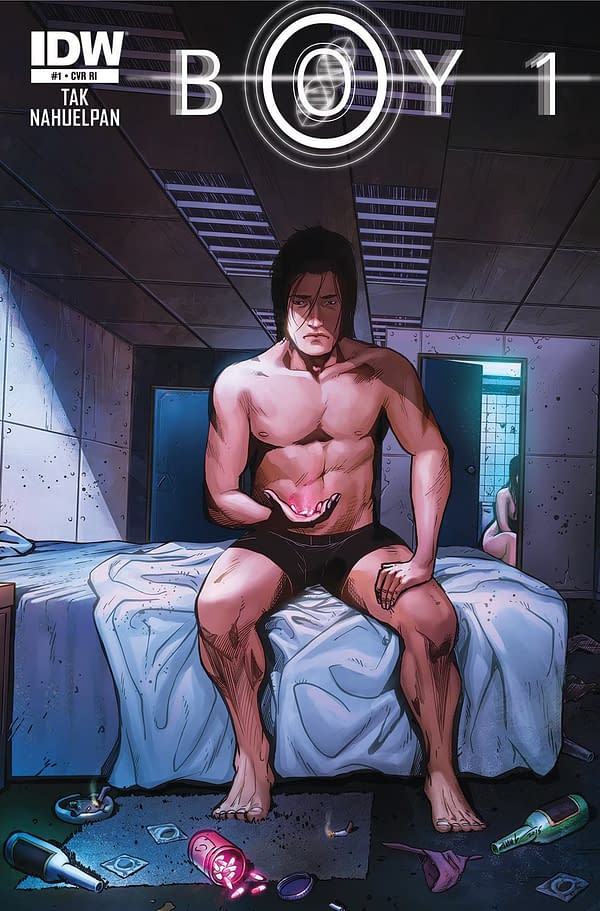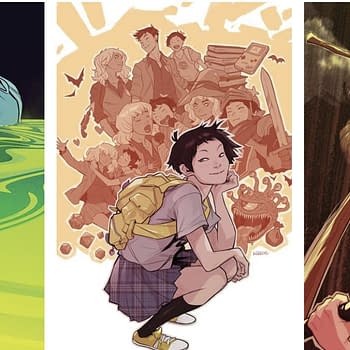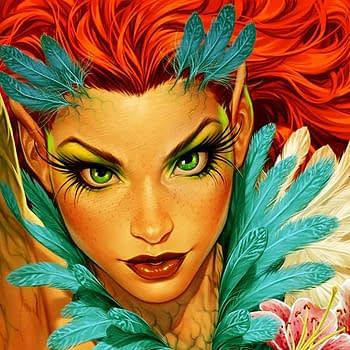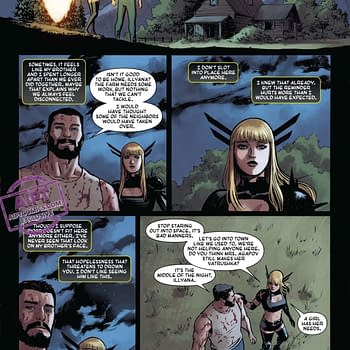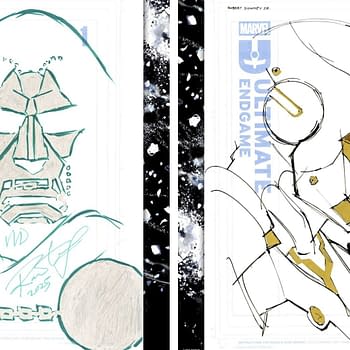Posted in: Comics | Tagged: Amancay Nahuelpan, boy -1, Comics, entertainment, H.S. Tak, NYCC
H.S. Tak And Amancay Nahuelpan Discuss Boy-1 And Humanity's Future At NYCC '15
If I've said it once, I've said it a dozen times. While at any comic con, there are innumerable opportunities to sit down and talk with creative writers and artists. Last week at New York Comic Con, I had the chance to meet writer H.S. Tak and artist Amancay Nahuelpan and discuss their latest comic for IDW, Boy-1.
Octavio Karbank: How do you describe Boy-1 to a new reader? What's it about?
HT: It's basically about what happens when a company creates the first modified human being and the world finds out. Basically, what happens next.
OK: Cool. Now, I really like asking this next question. In five words or less…
HT: Oh no!
OK: …Why should someone pick up Boy-1?
HT: Blade Runner meets Children of Men.
OK: That'll work. What makes Boy-1 unique? How is it different from other comics out there?
HT: I did a lot of research for this book. I know there are a few comics that are like that, that are science based. I talked to researchers at NIH, molecular biologists at MIT, and I just constructed a story. The crazy thing that I actually experienced when I talked to these researchers was what I thought I could do with Boy-1, and the future of genetic engineering. They're way beyond even what I could imagine already. The sciences of it are already happening, which is kind of crazy when you think about it. It really helped inform the book and inform how behind I was on what the potentials are for the futures of the science and the future of what's going to happen with genetic engineering and, basically, human evolution.
OK: Wonderful. Now for you, Amancay, what distinguishes your art in Boy-1 from other comic art?
AN: (laughs) I don't know. I try to reflect as much as possible what the script is describing, try to build this world that is quite unique, because there are lots of things that don't exist in the real world. It's kind of got a futuristic vibe, but it's also not that futuristic. It's very much like building and constructing this whole new world. It's very grounded, but at the same time fantastic like a video game a little bit. The architecture, for example, is something that I've enjoyed working on, I have these bright exteriors, and these night exteriors, and stuff like that. Then the interactions with the characters; I try to also add as much as possible in their expressions when they're interacting, with moods or scenarios within the story. I don't know if that makes it different, but that's how I try and standout…somehow.
OK: What was the origin behind Boy-1? How did you get the project started?
HT: I made a prototype and the idea came from reading science reports and staying up to date with current events. I think the first time I heard about designer babies, an idea sprouted, like what's going to happen in the future with this stuff? We're getting very close to the point where we can control human genealogy and the way humans are built, because we understand the blueprint for making human beings at a very micro level through their DNA. That was the idea. The process was a long one. It took a couple years. I had made a prototype of issue one with an artist. We shopped it around, basically just pounded the pavement, as I'm even doing now, running around comic cons, talking to different publishers and people in the industry to take a look at the book. Chris Ryall at IDW took a look at it, he liked it, he liked the art, and I was able to procure a deal with them. As soon as I got a deal, the artist sort of dropped out, because IDW is a big publisher and he thought he'd get paid a lot more, so he dropped out. Luckily IDW liked the idea enough to stick with me. I think Amancay must've been doing some kind of work with them, because they suggested him to me and we met from there.
OK: As the artist, what about the project intrigued you?
AN: First of all, I was surprised when they got me in touch with Himkar, because it came out of the blue, and Himkar sent me the screenplay and the original comic they had made before. Initially I wasn't very sure about working on it because of the style of the other artist. It was totally different to my style and I actually said that to Himkar, "This is totally different from what I do, are you sure about this?" and he was like, "Yeah, I'm totally sure." So from there, with the script in my hand and the story, it was something that was interesting for me to draw; it was the first thing I looked at, is this going to be something that 's challenging and fun to do? So it had all that and it's a genre I hadn't worked on before. It was all these different, new things I wanted to approach somehow. I was super stoked and interested from the first minute.
OK: Why this particular story for you? Why Boy-1?
HT: To be honest, man, I had a screenplay sitting around, about this whole arc for a guy who is the first human clone and biologically advanced human. Hollywood is a tough business, and it's hard to get producers to read your script, even though that's their job. I was just trying to figure a different angle that might help them see what this story could be. I converted that into issue one and went about finding an artist and getting it made.
OK: Can you talk about the future of Boy-1? Will there be a part two?
HT: We are a four-issue mini-series right now. Issue four is about to go into print, so it'll be out next month. We could elongate this story for sure. We did close the arc for the character. Generally when you make these initial stories, the main thing is the protagonist has to go through a change, and Jadas, in this instance does. So we've closed that arc, and we're open to doing another one, but at the moment I've gotten pulled on to another project and I think Amancay is on another project as well. There definitely is a chance that we could reconvene later.
OK: How did you break into the industry?
HT: I broke in sort of by going around. I did a prototype of issue one and I tried to get it in front of as many people as I could.
AN: From an artist's point of view, it's different because you're showing your portfolio everywhere. I've been talking to editors in conventions, sending emails, and getting in touch with writers. One thing brings the other and suddenly you're working with several writers or on different projects. For example now, with Clandestino, I'm writing and drawing and it's a whole new different story, because I'm in charge of everything. It's not just following what someone's scripts says, but it's me doing what I actually want to see on the piece of paper. Basically, for an artist, showing your stuff as much as possible. You start doing stuff for free at the beginning, like everyone; work long hours, and never stop working. It's very demanding to be a comic artist. It requires a lot of time and effort, you have to really believe that you want to be that and get somewhere, and the only way is working hard.
OK: Have you always wanted to work on comics?
HT: I've always read comics. I've always been a fan of comics; I never knew I could write a comic. I have a film writing background, so changing it into a comic book, is difficult. It's two very different mediums and you have to learn a different way of storytelling, but I've always been a fan. I would say that if I can do it, anyone else can do it too.
OK: What do comics mean to you?
AN: Everything. It's more than the fanboy in me, it's more a creative thing in me. I need to be constantly drawing and creating and working in the creative process, otherwise I go crazy. I always have a notepad with me to draw. Basically, comics, or illustration, or drawing, is pretty much what always motivates me to go ahead with everything. Even in my life, a lot of decisions are made because of my personal illustration or comic goals. It's definitely a very important part of me. They are super important to me.
HT: It's a tough question to answer in a short amount of time and succinctly. It's another medium of storytelling and the more mediums you can tell people's story, I think the better. The more the world gets enriched. Definitely, it's a place where outcasts can come together and get into their own world and live out their own fantasies. I think it's an important thing for people to have.
OK: What would you like a reader to take away from your work?
HT: I don't try to have expectations for it. I hope they can learn something. The greatest creators, the creators I look up to and admire and follow, are the ones from whom I can learn something new about the world, about myself, about how we live, and what we're doing right and what we're doing wrong. Hopefully it's just something that they can pick up on and…learn.
OK: Do you think people should read comics?
HT: Definitely, because reading is good for you. Comics allow people who are off the main grid to come together. It offers an incredible array of different kinds stories for people to get into. I mean, you've seen it yourself; the medium of comics is on the rise, an astronomical rise, from where it was ten years ago. People should read comics because you can learn a lot about how the world works and about different people.
AN: Of course! For children it's an excellent entryway into the reading world, because you have the images and all that stuff and its more entertaining than just reading a book without them. Then for adults, visually following the story, like for me, is so interesting and amazing. Books allow you to use your imagination and creativity when you're not seeing the pictures, but then when you see it, it's a totally different experience, because you get involved into a story, like a movie, and you see what's happening. They definitely are something people should read; pretty much everyone can read comics, because they're not for a specific group of people. It's a fascinating way to tell a story, that's the main thing. It's interesting visually. I guess that's what we should look for.
OK: What are some good movies to watch next to Boy-1?
AN: Blade Runner, Children of Men, Chinatown…
HT: '80s detective films, maybe some Polanski films.
OK: Who inspires you?
AN: Big influences for me have been Greg Capullo, Eduardo Risso, Stuart Immonen; those are the guys I really admire. Every time I see their work I feel so inspired I want to go ahead and keep working at my stuff. Someone who inspires me in life? My parents.
HT: I'm just going to piggyback off his answer, because I think it says it all. Other writers, other creators, filmmakers, and artists; those are the guys that inspire me. It's very simple. You just look around, read stuff, watch films, you go to museums, and see a work of art and you get inspired.
OK: Final question, and I ask everyone this: what does the craft of storytelling mean to you?
AN: Similar to my other answer about the creative process, it's kind of like a motor to keep me doing stuff. I have a need to create and telling a story through this medium is a way to expel that to the world. I have to get that out there.
HK: I think writing is life. It's a way of life. I don't think I know how to live any differently. You have these stories in you that you have to find a way to tell. It's just that simple.
OK: Cool. Thank you, both.
Octavio Karbank is a writer and bona fide Whovian. Living in Massachusetts, you can find him on Twitter @TymeHunter and his blog www.cozmicventures.com


